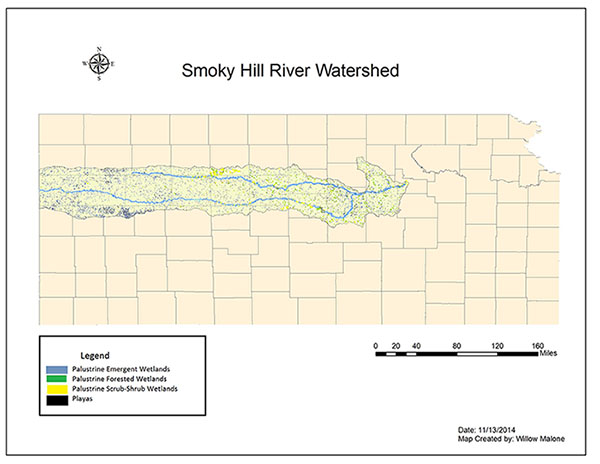Occurrence and Function of Playa Wetlands in the Smoky Hill River Watershed
 Investigators:
Investigators:
Willow Malone, M.S. Student
Project Supervisor:
Dr. David Haukos
Cooperators:
Dr. Melinda Daniels
Dr. Martha Mather
Dr. Marcellus Caldas
Dr. J. Heier Stamm
Dr. Jason Bergtold
Dr. Aleksey Sheshukov
Dr. Matthew Sanderson
Funding:
National Science Foundation
Location:
Smoky Hill River watershed
Completion:
November 2016
Status:
Completed
Objectives:
Identify the classification type, occurrence, and size of the wetlands in the Smoky Hill River Watershed.
Test the relationship between land use and playa hydrology through biotic variables of the playa wetland.
Develop a framework to predict the effects of environmental variation on playa hydrology and the effects it will have on the biodiversity
Results:
Playa wetlands are unique and complex ecological systems crucial to the ecology of the western Great Plains of North America. Playas offer a variety of ecological goods and services including flood water retention, water quality improvement, aquifer recharge, and provide critical habitat for a unique assemblage of resident and migratory biota. Anthropogenic changes to the land alter the function and presence of playa wetlands and the current estimates of the number of playas does not take the recent loss of playas into account, giving a false representation of the correct number of functional and existing playa wetlands. Landscape changes threaten the function and existence of playas, primarily through sediment accumulation in the playa wetland, which decreases the function, size, and hydroperiod of the playas. Legal protection against modifying a playa is not effective and results in continuing physical or functional loss of the playa. My objective was to determine the correct number of existing playa wetlands in the Smoky Hill River Watershed and compare to prior estimates. Using a Geographical Information System, I randomly selected 20% of the playa wetlands in the watershed for presence on the landscape and anthropogenic effects (n = 608). There were 3,310 polygons representing probable playas in the watershed. In the Smoky Hill River watershed, 22% of the randomly selected playa wetlands have been lost to the landscape (n = 134). Of the playa wetlands still present on the landscape, merely 5.1% (n = 31) were not impacted by landscape changes or anthropogenic effects. These results indicate that the current estimate of playa wetlands is incorrect. Furthermore, the current estimate of playa wetlands can be considered a threat to the future quantity and quality of wetlands.
Hydrology is the ecological driver of playa wetlands and greatly influenced by the surrounding Land-Use/Land-Cover. Avian and floral diversity has been known to be a key indicator of ecological function and will provide a quantitative measurement of playa functionality. My objective was to determine the relationship of surrounding land use (native grassland, cropland, Conservation Reserve Program) on avian use of playa wetlands in the dry ecological state. I conducted breeding bird surveys in >25 playa wetlands with differing watersheds to record occupancy, relative abundance, and species richness. Species diversity was derived using Simpson's index. Similar surveys were conducted in paired, non-playa habitats. Results reveal avian diversity is 7% greater in playa wetlands than non-playa areas. Further, avian diversity is greatest in grassland playas, with a 20% greater diversity index than the cropland playas, which had the lowest diversity. Plant species richness is 73% greater in grassland playas than cropland playas. Vegetative surveys confirm that playa wetlands offer a greater plant species richness than the floral community found in cropland playas or surrounding watershed.
Products:
Thesis:
Malone, Willow (M.S., 2016; advisor Haukos) Biodiversity in Playa Wetlands in Relation to Watershed Disturbance. Master's Thesis, Division of Biology, Kansas State University.
Professional Presentations:
Malone, W., and D. A. Haukos. 2017. How Playa Wetlands Influence Landscape Biodiversity: Small Depressions with Big Benefits. Midwest Fish and Wildlife Conference, Lincoln, NE.
Malone, Willow. 2016. The Influence of Watershed Condition on Avian Use of Dry Playa Wetlands. Kansas Natural Resources Conference, Wichita, KS.
Malone, W. 2016. Our essential freshwater source: Estimating the occurrence and function of playa wetlands in Western Kansas. Division of Biology, Graduate Student Forum, Kansas State University.
Malone, W., and D.A. Haukos. 2015. The influence of watershed condition on avian use and diversity of playa wetlands in western Kansas. Annual Meeting of the Kansas Ornithological Society, Emporia, KS
Malone, W., D. A. Haukos and M. D. Daniels. 2015. Our Essential Freshwater Source: Estimating the Occurrence and Function of Playa Wetlands in Western Kansas. Governor's Conference on the Future of Water in Kansas, Manhattan, KS. (poster)
Malone, W., and D.A. Haukos. 2015. The influence of watershed condition on avian use and diversity of playa wetlands in western Kansas. Annual meeting of the Central Mountains and Plains Section of The Wildlife Society, Manhattan, Kansas. (poster)
Malone, W.E.A., and D.A. Haukos. 2015. The influence of watershed condition on avian use of dry playa wetlands. Joint meeting of American Ornithologists' Union and Cooper Ornithological Society, Norman, OK.